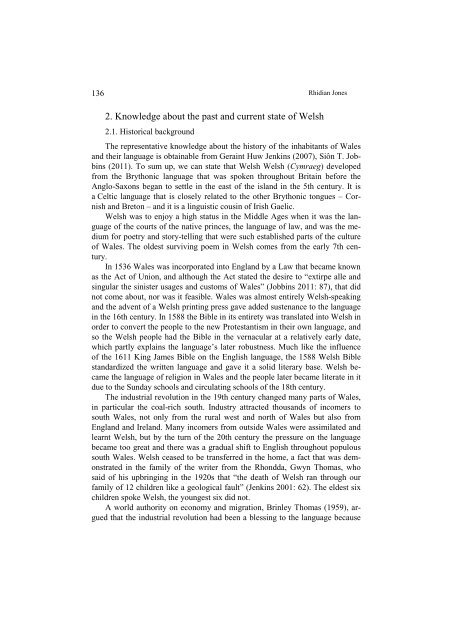s - Wyższa SzkoÅa Filologiczna we WrocÅawiu
s - Wyższa SzkoÅa Filologiczna we WrocÅawiu
s - Wyższa SzkoÅa Filologiczna we WrocÅawiu
Create successful ePaper yourself
Turn your PDF publications into a flip-book with our unique Google optimized e-Paper software.
136<br />
Rhidian Jones<br />
2. Knowledge about the past and current state of Welsh<br />
2.1. Historical background<br />
The representative knowledge about the history of the inhabitants of Wales<br />
and their language is obtainable from Geraint Huw Jenkins (2007), Siôn T. Jobbins<br />
(2011). To sum up, <strong>we</strong> can state that Welsh Welsh (Cymraeg) developed<br />
from the Brythonic language that was spoken throughout Britain before the<br />
Anglo-Saxons began to settle in the east of the island in the 5th century. It is<br />
a Celtic language that is closely related to the other Brythonic tongues – Cornish<br />
and Breton – and it is a linguistic cousin of Irish Gaelic.<br />
Welsh was to enjoy a high status in the Middle Ages when it was the language<br />
of the courts of the native princes, the language of law, and was the medium<br />
for poetry and story-telling that <strong>we</strong>re such established parts of the culture<br />
of Wales. The oldest surviving poem in Welsh comes from the early 7th century.<br />
In 1536 Wales was incorporated into England by a Law that became known<br />
as the Act of Union, and although the Act stated the desire to “extirpe alle and<br />
singular the sinister usages and customs of Wales” (Jobbins 2011: 87), that did<br />
not come about, nor was it feasible. Wales was almost entirely Welsh-speaking<br />
and the advent of a Welsh printing press gave added sustenance to the language<br />
in the 16th century. In 1588 the Bible in its entirety was translated into Welsh in<br />
order to convert the people to the new Protestantism in their own language, and<br />
so the Welsh people had the Bible in the vernacular at a relatively early date,<br />
which partly explains the language’s later robustness. Much like the influence<br />
of the 1611 King James Bible on the English language, the 1588 Welsh Bible<br />
standardized the written language and gave it a solid literary base. Welsh became<br />
the language of religion in Wales and the people later became literate in it<br />
due to the Sunday schools and circulating schools of the 18th century.<br />
The industrial revolution in the 19th century changed many parts of Wales,<br />
in particular the coal-rich south. Industry attracted thousands of incomers to<br />
south Wales, not only from the rural <strong>we</strong>st and north of Wales but also from<br />
England and Ireland. Many incomers from outside Wales <strong>we</strong>re assimilated and<br />
learnt Welsh, but by the turn of the 20th century the pressure on the language<br />
became too great and there was a gradual shift to English throughout populous<br />
south Wales. Welsh ceased to be transferred in the home, a fact that was demonstrated<br />
in the family of the writer from the Rhondda, Gwyn Thomas, who<br />
said of his upbringing in the 1920s that “the death of Welsh ran through our<br />
family of 12 children like a geological fault” (Jenkins 2001: 62). The eldest six<br />
children spoke Welsh, the youngest six did not.<br />
A world authority on economy and migration, Brinley Thomas (1959), argued<br />
that the industrial revolution had been a blessing to the language because
















